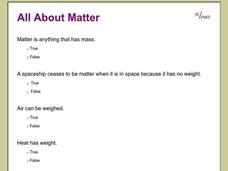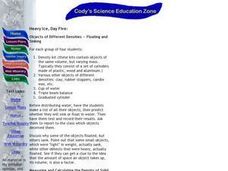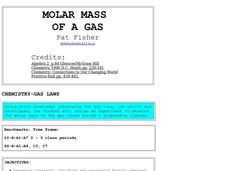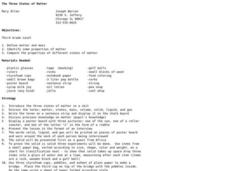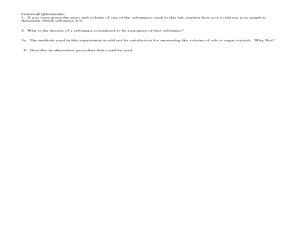Cornell University
Density
Certain things just do not mix, including liquids of varying densities. Learners collect data to determine the densities of several liquids. They then use the density information to predict the type of liquid.
Teach Engineering
Density Column Lab - Part 2
Groups suspend objects within layers of liquids to determine the densities of different liquids and compare them to the densities of objects calculated in Part 1. The groups then carefully test their calculations by layering the...
Teach Engineering
Floaters and Sinkers
Whatever floats your boat. Young engineers learn about density by measuring the masses and volumes of boxes filled with different materials. Using their knowledge of densities, they hypothesize whether objects with given densities will...
Curated OER
Measuring Body Fat
In this body fat measurement learning exercise, students will conduct an experiment to determine how the "under-water weighing" technique of measuring body fat works. Once the experiment is complete, students will complete 1 short answer...
Curated OER
Experiment on Measuring Reaction Rates
Students investigate the rate of a chemical reaction. In this rate of reactions lesson plan, students use an electronic balance to measure the change in mass of a chemical reaction between hydrochloric acid and calcium carbonate. They...
Curated OER
The Measurement Man
Students explore the measurements of capacity by constructing a creative project in the shape of a man. The man has body parts that represent different units of measurement and can be used to make conversions. This is highly concrete and...
Curated OER
Determining Liquid Densities
Students practice determining liquid densities in a short, hands-on lab activity. Students use a graduated cylinder to measure out 100 milliliters of a liquid, find its mass using a balance, and record measurements in a data table....
Curated OER
Egg Measurement
Students explore measurement and units. They measure eggs to determine their density, mass and percent composition. An inquiry approach is used for students to ascertain the mass.
Curated OER
Units of Measure
For this metric units of measurement worksheet, students read information about estimating lengths and masses, then solve 65 problems. Sample problems with solutions are included.
Curated OER
Chemistry Midterm Practice Exam
A comprehensive practice exam, this resource covers many areas of chemistry. The test includes 71 multiple choice questions on topics such as problem solving, chemical equations, chemical formulas, thermodynamics, acids and bases, and...
Curated OER
All About Matter
Twenty-four questions about matter, the states of matter and the properties of matter make up this interactive online learning exercise. Your class will determine the volume of water, the shape of water and the shapes of matter.
Curated OER
Causal Patterns in Density Phenomena
Students investigate the relationship between volume and mass in different liquids such as vegetable oil, rubbing alcohol and water. They measure the mass of several different volumes of each liquid and then graph the results as well as...
Curated OER
The Scientific Method
In this scientific method worksheet, students read about the steps of the scientific method, ways to measure mass and volume and how to read a meniscus. Students use the scientific method to determine if an object is a liquid or a solid...
Curated OER
Density Lab
In this biology worksheet, students use the website given to become familiar with the equipment of a lab. The activity involves a link to a virtual laboratory. Then they determine an objects mass and volume by placing it in a graduate...
Curated OER
Measuring Density
Young scholars explore the concept of density. They use the the formula Density = Mass/Volume, one can determine where certain liquids and objects will settle in a graduated cylinder. In addiiton, they design a process to separate the...
Curated OER
Time to lend NASA a hand
In this measurement worksheet, students complete an experiment answer questions about how they measure the units of volume, temperature, and mass of certain objects. Students answer 5 questions.
Curated OER
A Matter of Fact
Third graders define matter as anything that takes up space and has mass, recognize, through experimentation and observation, that matter exists in three forms, including solid, liquid, and gas, and discuss characteristics of each form...
Curated OER
Density Lab Activities
Students participate in several density lab activities in order to clarify the misconceptions that solids sink and liquids float. Students work with triple beam balances to find mass of objects to calculate density.
Curated OER
Heavy Ice: Day Five
Students explore physics by conducting a class experiment. In this density lesson, students examine a list of items and discuss whether they will sink or float and then determine their density. Students examine the objects over five days...
Curated OER
Molar Mass
Students apply the ideal gas law and Dalton's Law of Partial Pressure to develop an experiment which determine the molar mass of butane from disposable lighters. In small groups, they develop a procedure and have it approved before...
Curated OER
Density Laboratory Gizmo
In this mass instructional activity, students fill in a chart with different items and their volume, whether they float or sink, and their density. Students complete this for 10 items and answer 6 multiple choice mass questions.
Curated OER
Brain POP- Properties of Matter
In this properties of matter worksheet, students answer 18 questions about mass, density, volume or weight. All of the questions are multiple choice.
Curated OER
The Three States of Matter
Third graders identify properties of solids, liquids, and gasses. In this states of matter lesson, the teacher demonstrates the properties of each state of matter, then students go on a scavenger hunt for items to represent each state...
Curated OER
Mass and Density of an Irregular Solid
In this physics worksheet, students determine the density of irregular solids using water displacement method to complete 7 problems and short answer questions.












